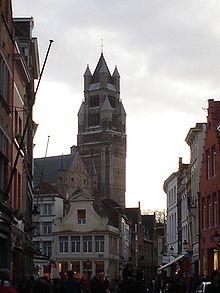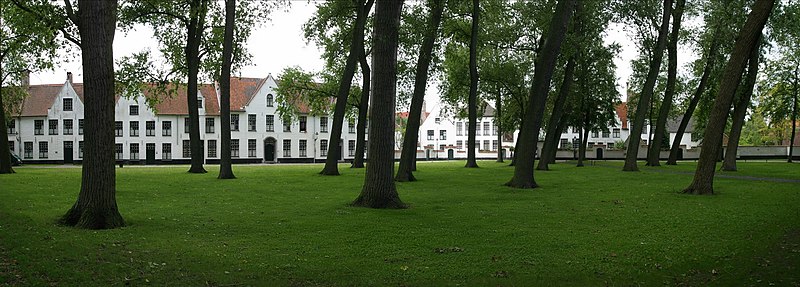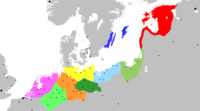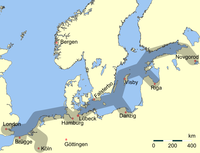Bruges
From Wikipedia, the free encyclopedia
| Bruges Brugge (Dutch) |
|||
|---|---|---|---|
 |
|||
|
|||
| Location of Bruges in West Flanders | |||
| Sovereign state | |||
| Region | |||
| Community | |||
| Province | |||
| Arrondissement | Bruges | ||
| Coordinates | Coordinates: | ||
| Area | 138.40 km² | ||
| Population – Males – Females - Density |
117,224 (January 1, 2006) 48.43% 51.57% 847 inhab./km² |
||
| Age distribution 0–19 years 20–64 years 65+ years |
(01/01/2006) 20.57% 59.34% 20.09% |
||
| Foreigners | 3.52% (01/01/2007) | ||
| Unemployment rate | 7.40% (January 1, 2006) | ||
| Mean annual income | €13,617/pers. (2003) | ||
| Mayor | Patrick Moenaert (CD&V) | ||
| Governing parties | CD&V, SP.A-Spirit, VLD | ||
| Postal codes | 8000, 8200, 8310, 8380 | ||
| Area codes | 050 | ||
| Website | www.brugge.be | ||
Bruges (Dutch: Brugge) is the capital and largest city of the province of West Flanders in the Flemish Region of Belgium. It is located in the northwest of the country.
The historic city centre is a prominent World Heritage Site of UNESCO. It is egg-shaped and about 430 hectares in size. The area of the whole city amounts to more than 13,840 hectares, including 193.7 hectares off the coast, at Zeebrugge ("Seabruges" in literal translation). The city's total population is 117,073 (1 January 2008),[1] of which around 20,000 live in the historic centre. The metropolitan area, including the outer commuter zone, covers an area of 616 km² and has a total of 255,844 inhabitants as of 1 January 2008.[2]
Along with a few other canal-based northern cities, it is sometimes referred to as "The Venice of the North".
Bruges has a significant economic importance thanks to its port, and is also home to the College of Europe.
Contents |
[edit] History
[edit] Origins
Very few traces of human activity date from the Pre-Roman Gaul era. The first fortifications were built after Julius Caesar's conquest of the Menapii in the first century BC, to protect the coastal area against pirates. The Franks took over the whole region from the Gallo-Romans around the 4th century and administered it as the Pagus Flandrensis. The Viking incursions of the ninth century prompted Baldwin I, Count of Flanders to reinforce the Roman fortifications; trade soon resumed with England and Scandinavia. It is at around this time that coins appeared for the first time bearing the name Bryggia. This name may stem from the Old Norse Bryggja, meaning "landing stage" or "port",[3] and may have the same origin as Norway’s Bryggen.
[edit] Golden Age (12th to 15th century)

Bruges got its city charter on July 27, 1128 and built itself new walls and canals. Since about 1050, gradual silting had caused the city to lose its direct access to the sea. A storm in 1134, however, re-established this access, through the creation of a natural channel at the Zwin. The new sea arm stretched all the way to Damme, a city that became the commercial outpost for Bruges.
With the reawakening of town life in the twelfth century, a wool market, a woollens weaving industry, and the market for cloth all profited from the shelter of city walls, where surpluses could be safely accumulated under the patronage of the counts of Flanders. Bruges was already included in the circuit of the Flemish cloth fairs at the beginning of the thirteenth century. The city's entrepreneurs reached out to make economic colonies of England and Scotland's wool-producing districts. English contacts brought Normandy grain and Gascon wines. Hanseatic ships filled the harbor, which had to be expanded beyond Damme to Sluys to accommodate the new cog-ships. In 1277, the first merchant fleet from Genoa appeared in the port of Bruges, first of the merchant colony that made Bruges the main link to the trade of the Mediterranean. This development opened not only the trade in spices from the Levant, but also advanced commercial and financial techniques and a flood of capital that soon took over the banking of Bruges. The Bourse opened in 1309 and developed into the most sophisticated money market of the Low Countries in the fourteenth century. By the time Venetian galleys first appeared, in 1314, they were latecomers.[4]
Such wealth gave rise to social upheavals, which were for the most part harshly contained. In 1302, however, after the Bruges Matins (the nocturnal massacre of the French garrison in Bruges by the members of the local Flemish militia on 18 May 1302), the population joined forces with the Count of Flanders against the French, culminating in the victory at the Battle of the Golden Spurs, fought near Kortrijk on July 11. The statue of Jan Breydel and Pieter de Coninck, the leaders of the uprising, can still be seen on the Big Market square.
In the 15th century, Philip the Good, duke of Burgundy set up court in Bruges, as well as Brussels and Lille, attracting a number of artists, bankers, and other prominent personalities from all over Europe.
The new Flemish-school, oil-painting techniques gained world renown. The first book in English ever printed was published in Bruges by William Caxton. This is also the time when Edward IV and Richard III of England spent time in exile here. The population swelled to more than 40,000 inhabitants.
[edit] 16th century until now

| Please help improve this article or section by expanding it. Further information might be found on the talk page. (September 2008) |
Starting around 1500, the Zwin channel, which had given the city its prosperity, also started silting. The city soon fell behind Antwerp as the economic flagship of the Low Countries. During the 17th century, the lace industry took off and various efforts to bring back the glorious past were made. During the 1650s the city was the base for the court of Charles II of England and his court in exile [5]. The maritime infrastructure was modernized, and new connections with the sea were built, but without much success. Bruges became impoverished and gradually disappeared from the picture. The symbolist novelist George Rodenbach even made the sleepy city into a character in his novel Bruges-la-Morte meaning "Bruges-the-dead", which was adapted into Erich Wolfgang Korngold's opera, 'Die tote Stadt (The Dead City). In the last half of the 19th century Bruges became one of the world's first tourist destinations attracting wealthy British and French tourists. Only in the second half of the twentieth century has the city started to reclaim some of its past glory. The port of Zeebrugge was built in 1907. The Germans used it for their U-boats in World War I. It was greatly expanded in the 1970s and early 1980s and has become one of Europe's most important and modern ports. International tourism has boomed and new efforts have resulted in Bruges being designated 'European Capital of Culture' in 2002.
[edit] Geography
The municipality comprises:
|
[edit] Sights
| Historic Centre of Bruges* | |
|---|---|
| UNESCO World Heritage Site | |
|
|
|
| State Party | |
| Type | Cultural |
| Criteria | ii, iv, vi |
| Reference | 996 |
| Region** | Europe and North America |
| Inscription history | |
| Inscription | 2000 (24th Session) |
| * Name as inscribed on World Heritage List. ** Region as classified by UNESCO. |
|
Bruges has most of its medieval architecture intact. The historic centre of Bruges is a UNESCO World Heritage Site since 2000.[6]
Many of its medieval buildings are notable, including the Church of Our Lady, whose brick spire — at 122m — makes it one of the world's highest brick towers/buildings. The sculpture Madonna and Child, which can be seen in the transept, is believed to be Michelangelo's only sculpture to have left Italy within his lifetime.
Bruges is also famous for its thirteenth-century belfry, housing a municipal carillon comprising 47 bells. The city still employs a full-time carillonneur, who gives free concerts on a regular basis.
Other famous buildings in Bruges include:
- The Beguinage
- The Basilica of the Holy Blood (Heilig-Bloedbasiliek). The relic of the Holy Blood, which was brought to the city during the First Crusade, is paraded every year through the streets of the city. More than 1,600 inhabitants take part in this mile-long religious procession, many dressed as medieval knights or crusaders.
- The modern Concertgebouw ("Concert Building")
- The Old St-John's Hospital
- The Saint-Salvator Cathedral
- The Groeningemuseum
- The City Hall on the Burg square
- The Provincial Court (Provinciaal Hof)
- The preserved old city gateways: the Kruispoort, the Gentpoort, the Smedenpoort and the Ezelpoort. The Dampoort, the Katelijnepoort and the Boeveriepoort are gone.
Bruges also has a very fine collection of medieval and early modern art, including the world-famous collection of Flemish Primitives. Various masters, such as Hans Memling and Jan van Eyck, lived and worked in Bruges.
|
Bridge at Bruges, (ca. 1919) |
[edit] Culture and art
[edit] Theatres and concert halls
- Aquariustheater
- Biekorf
- Concertgebouw ("Concert Building")
- De Dijk
- De Werf
- Het Entrepot
- Joseph Ryelandtzaal
- Magdalenazaal
- Sirkeltheater
- Stadsschouwburg
- Studio Hall
- Zwart Huis (before also The English Theatre of Bruges)
[edit] Cinemas
- Cinema Lumière (alternative movies)
- Cinema Liberty
- Kinepolis Bruges
[edit] Festivals
|
|
[edit] Museums
[edit] Municipal museums
- Artistic works from the 15th to 21st century:
- Groeningemuseum
- Arents House (contains a Frank Brangwyn museum and a museum for ever-changing exhibitions of expressive art)
- Forum+ (part of the Concertgebouw; has exhibitions of contemporary art)
- The Bruggemuseum ("Bruges Museum") (general name for 11 different historical museums in the city):
- Gruuthusemuseum
- Welcome Church of Our Lady
- Archaeological Museum
- Gentpoort
- Belfry
- City Hall
- Liberty of Bruges
- Museum of Folklore
- Guido Gezelle Museum
- Koelewei (Cool Meadow) Mill
- Sint-Janshuis (St. John’s House) Mill
- Hospitalmuseums:
- Old St John’s Hospital (Hans Memling)
- Our Lady of the Potteries
[edit] Non-municipal museums
- Beguine's House
- Brewery museum
- Hof Bladelin
- Basilica of the Holy Blood
- Choco-Story (chocolate museum)
- Lumina Domestica (lamp museum)
- Museum-Gallery Xpo: Salvador Dalí
- Diamond Museum
- English Convent
- Frietmuseum (museum dedicated to Belgian Fries)
- Jerusalem Church
- Lace centre
- St. George’s Archers Guild
- Saint-Salvator Cathedral
- St. Sebastian’s Archers’ Guild
- St. Trudo Abbey
- Public Observatory Beisbroek
- Ter Doest Abbey (in Lissewege)
- Bogardenkapel (exhibition room)
- De Bond (creation and exhibition rooms)
- Jan Garemijnzaal (exhibition room)
[edit] Transport
[edit] Road
Bruges has excellent motorway connections to all directions:
- A10 to Ostend
- A10/E40 to Ghent and Brussels
- A18/E40 to Veurne and France
- A17/E403 to Kortrijk and Tournai
- N31/E403 to Zeebrugge
- N49/E34 to Antwerp
Driving within the 'egg', the historical centre enclosed by the main circle of canals in Bruges, is discouraged by traffic management schemes, including a network of one way streets. The system encourages the use of set routes leading to central car parks and direct exit routes. The car parks are convenient for the central commercial and tourist areas; they are inexpensive.
[edit] Railway
Bruges' main railway station is the focus of lines to the Belgian coast. It also provides at least hourly trains to all other major cities in Belgium, as well as to Lille, France. Further there are several regional and local trains.
The main station is also a stop for the Thalys train Paris–Brussels–Ostend.
Bus links to the centre are frequent, though the railway station is just a 10 minute walk from the main shopping streets and a 20 minute walk from the Market Square.
Plans for a north–south light rail connection through Bruges, from Zeebrugge to Lichtervelde, and a light rail connection between Bruges and Ostend are under construction.
[edit] Air
The national Brussels Airport, one hour away by train or car, offers the best connectivity. The nearest airport is the Ostend-Bruges International Airport in Ostend (around 25 km from the city centre of Bruges), but it offers limited passenger transport and connections.
[edit] Public city transport
Bruges has an extensive web of bus lines, operated by De Lijn, providing access to the city centre and the suburbs (city lines, Dutch: stadslijnen) and to many towns and villages in the region around the city (regional lines, Dutch: streeklijnen).
In support of the municipal traffic management (see "Road" above), free public transport is available for those who park their cars in the main railway station car park.
[edit] Cycling
Although a few streets are restricted, no part of Bruges is car free.
Cars are required to yield to pedestrians and cyclists. Plans have long been under way to ban cars altogether from the historic center of Bruges or to restrict traffic much more than it currently is, but these plans have yet to come to fruition. In 2005, signs were changed for the convenience of cyclists, allowing two-way cycle traffic on more streets, however car traffic has not decreased. Recent cycle fatalities have increased pressure to close bridges and further calm inner Bruges, but laws have not yet passed. Due to heavily populated suburbs, bus traffic is high on the narrow streets. This makes cycling even trickier.
Nevertheless, in common with many cities in the region, there are thousands of cyclists in the city of Bruges.
[edit] Port
The port of Bruges is Zeebrugge. It's the most modern and second biggest port of Belgium and one of the most important in Europe.
[edit] Sports
- Bruges is traditionally the starting town for the annual Ronde van Vlaanderen cycle race, held in April and one of the biggest sporting events in Belgium.
- Bruges is also a football town, represented by two teams at the top level (Belgian First Division): Club Brugge K.V. and Cercle Brugge K.S.V., both playing in the Jan Breydel Stadium (30,000 seats). Although, Club Brugge has plans for a new stadium with about 40,000 seats.
[edit] Education
Bruges is an important centre for education in West Flanders. Next to the several common primary and secondary schools, there are a few colleges, like the KHBO (Katholieke Hogeschool Brugge-Oostende) or the HOWEST (Hogeschool West-Vlaanderen). Furthermore, the city is home to the College of Europe, a prestigious institution of postgraduate studies in European Economics, Law and Politics.
[edit] Town twinning policy
On principle, Bruges has to date never entered into close collaboration with twin cities. Without denying the usefulness of this schemes for towns with fewer international contacts, the main reason is that Bruges would find it difficult to choose between cities and thinks that it has enough work already with its many international contacts. Also, it was thought in Bruges that twinning was too often an occasion for city authorities and representatives to travel on public expense.
This principle resulted, in the 1950s, in Bruges refusing a jumelage with Nice and other towns, signed by a Belgian ambassador without previous consultation. In the 1970s, a Belgian consul in Oldenburg made the mayor of Bruges sign a declaration of friendship which he tried to present, in vain, as a jumelage.
The twinning between some of the former communes, merged with Bruges in 1971, were discontinued.
This does not mean that Bruges would not be interested in cooperation with others, as well in the short term as in the long run, for particular projects. Here follow a few examples.
 Bastogne, Luxembourg, Belgium
Bastogne, Luxembourg, Belgium - After World War II and into the 1970s, Bruges, more in particular the Fire Brigade of Bruges, entertained friendly relations with Bastogne. Each year a free holiday was offered at the seaside in Zeebrugge, to children from the Nuts city.
 Arolsen, Hesse, Germany
Arolsen, Hesse, Germany - From the 1950s until the 1980s, Bruges was the patron of the Belgian First Regiment of Horse Guards, quartered in Arolsen
 Salamanca, Castilla y León, Spain
Salamanca, Castilla y León, Spain - Both towns having been made European Capital of Culture in 2002, Bruges had some exchanges organized with Salamanca.
 Mons, Hainaut, Belgium
Mons, Hainaut, Belgium - In 2007, cultural and artistic cooperation between Mons and Bruges was inaugurated.
 Burgos, Castilla y León, Spain
Burgos, Castilla y León, Spain - On 29 January 2007, the mayors of Burgos and Bruges signed a declaration of intent about future cooperation on cultural, touristic and economic matters.
[edit] Famous inhabitants
The following people were born in Bruges:
- Jan Breydel and Pieter de Coninck, freedom fighters
- Philip I of Castile, first Habsburg ruler in Spain (1478–1506)
- Adrian Willaert, composer of the Renaissance, (birth in Bruges uncertain, c. 1490-1562)
- Simon Stevin, mathematician and engineer (1548–1620)
- Franciscus Gomarus, Calvinist theologian (1563–1641)
- Guido Gezelle, poet and priest (1830–1899)
In the 15th century, the city became the magnet for a number of prominent personalities:
- Philip the Good, Duke of Burgundy set up court in Bruges, Brussels, and Lille in the 15th century
- William Caxton, English merchant, diplomat, writer, and printer
- Petrus Christus, Flemish painter
- Gerard David, Flemish painter
- Hans Memling, Flemish painter
- Jan van Eyck, Flemish painter
- Juan Luís Vives, Spanish scholar and humanist
- Simon Bening and Levina Teerlinc, Limners
[edit] Miscellaneous
- Bruges is known for its lace.
- Several beers are named after Bruges, such as Brugge Blond, Brugge Tripel, Brugs, Brugse Babbelaar, Brugse Straffe Hendrik and Brugse Zot. However, only Brugse Zot and Brugse Straffe Hendrik are still brewed in the city itself, in the Halve Maan Brewery.
- In Sint-Michiels is the amusement park Boudewijn Seapark with the dolphinarium.
- Fiction:
- Bruges-la-Morte, a short novel by the Belgian author Georges Rodenbach, first published in 1892.
- In Bruges, a film from Oscar-winning director Martin McDonagh, starring Colin Farrell and Brendan Gleeson, is set almost entirely in Bruges.
- The detective stories of Pieter Aspe are situated in Bruges.
- The Nun's Story, a dramatic film released by Warner Bros. Pictures in 1959, is entirely set in Bruges.
- Niccolò Rising, part of the 8 book House of Niccolo series by Dorothy Dunnett is largely set in Bruges.
- Floris, a Dutch television action series, written by Gerard Soeteman
- Alan Hollinghurst's novel The Folding Star is set in a Flemish town that is recognisably Bruges.
- L'Astrologue de Bruges, a Belgian bande dessinée in the Yoko Tsuno series by Roger Leloup, is entirely set in Bruges, both contemporary and in 1545.
[edit] Panoramas
[edit] External links
| Wikimedia Commons has media related to: Brugge |
- Official Website, also available in Dutch, French and German
- Tourist:
- Pictures, panoramas and webcams:
- Other:
[edit] References
- ^ Statistics Belgium; Population de droit par commune au 1 janvier 2008 (excel-file) Population of all municipalities in Belgium, as of 1 January 2008. Retrieved on 2008-10-19.
- ^ Statistics Belgium; De Belgische Stadsgewesten 2001 (pdf-file) Definitions of metropolitan areas in Belgium. The metropolitan area of Bruges is divided into three levels. First, the central agglomeration (agglomeratie), which in this case is Bruges municipality, with 117,073 inhabitants (2008-01-01). Adding the closest surroundings (banlieue) gives a total of 166,502. And, including the outer commuter zone (forensenwoonzone) the population is 255,844. Retrieved on 2008-10-19.
- ^ Bruges - A brief historical background.
- ^ Braudel, Fernand, The Perspective of the World, in Vol.III Civilization and Capitalism, 1984
- ^ Charles, Prince of Wales, (later Charles II), 1630-85
- ^ Historic centre of Bruges becomes a UNESCO World Heritage Site
|
||||||||||||||||||||||||||
|
|||||
|
|||||||
|
||||||||||||||||||||||||||











































